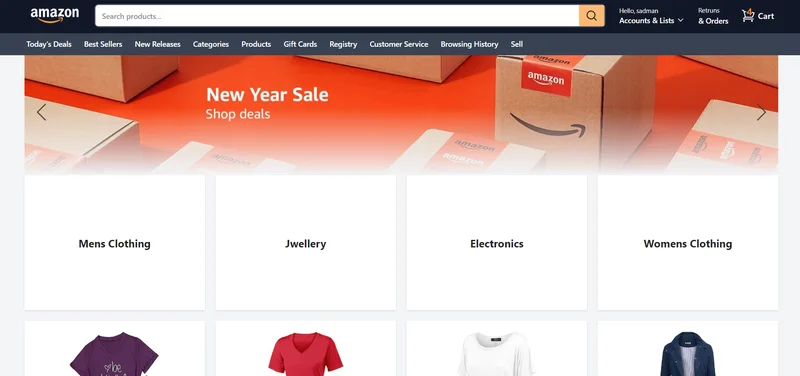It’s easy to get lost in the narrative surrounding Amazon. The company is no longer just an e-commerce giant; it’s an AI powerhouse, a cloud computing behemoth, and a logistics network that rivals the infrastructure of some nation-states. With a market cap hovering around $2.4 trillion and trailing-12-month sales of $670 billion, its scale is almost abstract.
The current story, the one capturing headlines, is How Amazon’s (AMZN) AI Tools Are Changing the Way Sellers List Their Products. We’re told that merchants are abandoning old-school keyword stuffing in favor of conversational, human-like product listings. This new approach, optimized for Amazon’s chatbot Rufus, is apparently yielding impressive results. Some sellers are reporting sales boosts of 15% to 20%—a significant lift in a hyper-competitive marketplace. On the surface, it’s a clean, compelling story of technological progress translating directly into commerce.
But narratives don’t pay for server farms. For that, we need to look past the marketing copy and focus on the one number that cuts through the noise: Free Cash Flow (FCF).
The Violent Swing in Cash Generation
Free cash flow is the lifeblood of any business. It’s the cash left over after a company pays its operating expenses and, crucially, its capital expenditures (the money spent on maintaining and growing its physical assets). It is, in my view, a far more honest measure of profitability than the accounting gymnastics of net income.
And for Amazon, the FCF story has been a roller coaster. After bleeding cash in 2021 and 2022, the company staged a remarkable turnaround, generating a positive FCF of $36.8 billion in 2023 and an even better $38.2 billion in 2024. This recovery signaled a return to operational discipline, a tightening of the belt after years of pandemic-fueled expansion. The market loved it. The numbers showed a mature, cash-generating machine.
But that trend is about to reverse, and sharply.
I've looked at hundreds of financial forecasts, and this is the part of the Amazon story that I find genuinely puzzling. Despite the positive momentum, analyst consensus projects Amazon’s FCF will plummet this year to $23.5 billion. That isn't a minor dip; it’s a nearly 40%—to be more exact, a 38.5%—year-over-year contraction. A nearly $15 billion drop in cash generation.

Why? The answer is a single, two-letter acronym: AI. Amazon is pouring capital into building out the infrastructure to power the next generation of artificial intelligence. This isn’t about chatbot interfaces or listing optimizers; this is the foundational layer of servers, data centers, and proprietary chips. The company is essentially building a massive, invisible factory for intelligence, and the construction costs are staggering.
The Disconnect Between Spending and Selling
This is where the slick narrative about seller success begins to diverge from the balance sheet reality. The AI tools driving those 15-20% sales bumps for third-party merchants are merely the most visible leaves on a tree that is costing billions to plant and water.
Think of it this way: Amazon is building a continent-spanning, multi-trillion-dollar superhighway system for an AI-driven future. The promise is that this highway will eventually be filled with revenue-generating traffic. But right now, the company is just pouring the concrete and steel (the capital expenditures), and the immediate cost is a massive drain on cash. The "tolls" collected from things like AI-optimized product listings are, at this stage, pocket change relative to the construction bill.
This creates a critical question that every investor should be asking: What is the measurable, near-term return on this monumental capital outlay? The connection between spending billions on data centers and a seller moving 15% more coffee mugs is tenuous at best. We have a clear number for the cost (a projected $14.7 billion FCF decline), but a very fuzzy, anecdotal one for the immediate benefit.
Wall Street analysts, with their 43 "Buy" ratings, seem entirely comfortable with this ambiguity. Their price targets imply a 23.9% upside, suggesting a deep faith that these massive AI investments will inevitably pay off. But faith is not a financial metric. When a company’s FCF is projected to contract so severely, it introduces a tangible element of risk. What if the timeline for AI monetization is longer than expected? Or what if a significant portion of this spending is purely defensive, a necessary cost to simply keep pace with Microsoft and Google, rather than a driver of new, high-margin revenue streams?
The details on the specific ROI hurdles for these internal AI projects remain scarce. The company is spending heavily, but the precise link between that spending and a corresponding increase in enterprise value is a black box.
A $15 Billion Question Mark
The story of AI-powered seller tools is a good one, but it’s a distraction. It’s a micro-level benefit being used to justify a macro-level expenditure of breathtaking scale. While the market is focused on the potential of Rufus and ImageSmith, it seems to be glossing over the immediate, quantifiable impact on the company's cash-generating ability.
Wall Street's "Strong Buy" consensus is pricing in a flawless execution of this AI transition. It assumes every billion spent on infrastructure will translate into multiples of that in future earnings. My analysis suggests that the execution risk embedded in a $15 billion FCF contraction is being significantly under-priced. The AI narrative is compelling, but the numbers are flashing a clear, unambiguous warning sign. For now, the most important story at Amazon isn’t about what its AI can do—it’s about what it costs.
